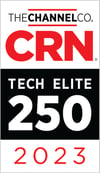Multi-factor authentication (MFA) protects sensitive data by requiring 2 or more factors to grant access. These factors typically include something you know, something you have, or something you are.
Your company can’t afford a delay in implementing MFA because of increasing security threats, the need to supplement other forms of IT security, and the importance of developing the strongest security posture possible.
Facing Today’s Threat Landscape
The current threat landscape includes both internal and external threats, both of which can be eliminated using MFA. Employees can become a security liability when they access information that is not appropriate to their job level. MFA defends against such internal threats by requiring users to submit several pieces of information to gain access to data and applications.
MFA is also effective against today’s common external threats, such as account takeover, business email compromise (BEC), and phishing attacks. With MFA, your company has a better chance of protecting your email, a tool that has become both a crucial channel of communication in this era of remote work and a key point of vulnerability.
Taking a Layered Approach to Security
MFA takes a layered approach to security by forcing users to go through several steps to gain access to accounts. Relying exclusively on passwords as a defense has proven inadequate. Passwords can be cracked easily using software, and employees often use weak passwords, set the same password for different accounts, or neglect to change default passwords.
MFA uses additional factors to verify a user’s identity, such as one-time use codes, personal questions, and tokens. A user must perform 2 or 3 actions to gain access. In response to some users’ objections about the effort involved, some MFA solutions judge whether an access attempt seems suspicious before asking for further authorization. Access attempts from a new location or unfamiliar device could be red flags.
MFA can also be included as part of an overall multilayered approach to security that may include firewalls, security information and event management (SIEM), and a secure wireless network.
Achieving Zero Trust Security
As cyberthreats become more sophisticated, Zero Trust security, with its principles of never trust; always verify, has become the gold standard for information security. Identity and access management solutions are an important part of a Zero Trust Architecture (ZTA) because they focus on verifying the authority of a user.
MFA plays an important part in identity and access management by ensuring that only authorized users have access to mission-critical data and applications. Every user’s identity is put into question and must be approved before gaining access.
Start Implementing MFA
The 2020 Identity and Access Management Report found that a little over half of the companies surveyed were prioritizing MFA as an investment. If your company hasn’t implemented MFA yet, now is the time to get started.
Don’t wait for a hacker to strike before strengthening your identity and access management with MFA. Working with the right partner will help you overcome any challenges that have caused you to hesitate.
ProActive Solutions offers identity and access management as part of our focus area in security and compliance. We can help your company with MFA deployment and support as part of an overall security strategy. Using our consultative approach, we work with your team to identify any implementation challenges, overcome them, and set up MFA for an updated approach to security.
Don’t put off adopting MFA another day. Reach out to ask for a personalized security whiteboard session with ProActive.



